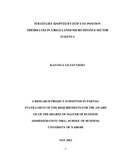| dc.description.abstract | Organizations can only adapt to changes in the macro-environment. Tney neither can
change the environment nor stop it from changing. When fundamental, sometimes
structural, economic, political and social change occurs, strategic planning places
an organization in a more agile state of preparedness, more attuned to market and other
external conditions and therefore better prepared to flex or substantially change their
strategic thrusts and operational plans at both local and higher corporate levels (Koch,
2006). The Micro Finance industry in Kenya has been faced with a changing financial and
regulatory environment with the establishment of the Micro- Finance 2008 act. This
research project provides an overview on the concept of strategy and the DTMFI sector
besides evaluating competitive and positioning strategies at play•.• The research sought to
identify the various strategies adopted by DTMFI's to position them for success and a
sustainable future in the now regulated MFI industry. The population of study was
restricted to the eight DTMFI's licensed since the regulation of the MFI industry by CBK,
namely: Faulu, KWFT, Rafiki, Remu, SMEP, Uwezo, Century and SUMAC. A ninth one,
U & I DTM was licensed in May, 2013, at the point of finalizing this research and therefore
could not form part ofthe study. The study involved the period of time since the licensing
date of the MFI to present, meaning the first five years since regulatory regime set in. The
first chapter analyzed the literature relating to Strategic Management, Competitive
strategy, positioning strategy and how they interact for successful management of firms. In
the literature review, it was established that the concepts of competitive and positioning
strategies interplay in determining the overall long term success of an organization in the
face of a rapidly changing environment. (Mintzberg & Waters, 1985). Secondly, the
process of adopting strategies that are resilient enough to create a unique place in the
market is not an easy task, but working towards improving the company's productivity
while staying true to the core competencies and positioning efforts can yield excellent
results. In essence, the literature review provided a theoretical foundation on how critical
the competitive and positioning strategies are in charting the direction of a firm. The study
data was collected through a Cross-sectional survey and judgement sampling method was
applied. In order to address the primary objectives of the research, a structured
questionnaire was created using SurveyMonkey, a web based survey tool that is used to
define the survey and capture responses from the various respondents through email.
SurveyMonkey is an excellent instrument for surveys that provides tools to make surveying
easy and strong analytics to interpret the results, gather the data as well as commence the
analysis ( (Blinklist Web Apps, 2013). Factor analysis was applied as well in the data
analysis process. The results collected for this research revealed that DTM's in Kenya
employ a combination of strategies to position themselves for success. The results also
indicated that differentiation strategy is one of the most applied for competitive advantage.
The researcher recommends that Managers ensure that strategy deals with the barriers to
goal achievement for it to be effective and verify that their goals are consistent with their
mission and vision as well as adoption of a clear strategy so that all stake holders share the
strategic vision of the' organization. The researcher also recommends for a posttransformation
period strategy which clearly stipulates how the institution will maintain its
original mission and remain competitive. Further to this, the researcher recommends
further studies to be carried out in the area of the process of managing change by DTM's
in a regulated industry to shed more light to the transitioning MFI's. | en_US |

